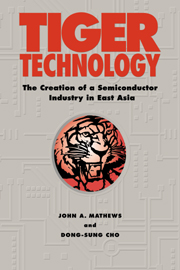Book contents
- Frontmatter
- Contents
- List of Figures
- List of Tables
- Preface
- Abbreviations
- Introduction
- Part I The ‘Real’ East Asian Miracle
- Part II National Institutional Pathways
- Part III The Technology Leverage Strategy
- 6 East Asian Semiconductor Industries: National Strategies and Sustainability
- 7 Limits to Technology Leverage Strategies
- 8 National Systems of Economic Learning: Lessons from East Asia
- Appendix I Exchange Rates: 1975–97
- Appendix II Chronolog
- Glossary
- Bibliography
- Index
6 - East Asian Semiconductor Industries: National Strategies and Sustainability
Published online by Cambridge University Press: 09 October 2009
- Frontmatter
- Contents
- List of Figures
- List of Tables
- Preface
- Abbreviations
- Introduction
- Part I The ‘Real’ East Asian Miracle
- Part II National Institutional Pathways
- Part III The Technology Leverage Strategy
- 6 East Asian Semiconductor Industries: National Strategies and Sustainability
- 7 Limits to Technology Leverage Strategies
- 8 National Systems of Economic Learning: Lessons from East Asia
- Appendix I Exchange Rates: 1975–97
- Appendix II Chronolog
- Glossary
- Bibliography
- Index
Summary
Our exposition so far has provided a detailed account of the creation of the semiconductor industry in four East Asian countries. We have analysed the organisational and institutional strategies employed, and sought to account for the achievements outlined in Chapter 1. We now shift gear to examine the strategies employed in comparative perspective, probing them for strengths and weaknesses.
In this chapter, we confine our attention to the semiconductor industry, looking at the character of the industry created in each of the different countries, and extrapolating from this to analyse, at least to a first approximation, what may be the core strengths and the potential pitfalls of the leverage and learning approach to creating new industries. The advantage of our approach is that we are focusing on a single industry, over the course of its entire trajectory. Thus, many of the concerns and issues expressed in more general terms by other scholars can be tackled with greater precision in the case of this specific industry, and be subjected to more searching scrutiny. We examine the institutional pathways followed by the industry creation process characteristic of each country, look at their commonalities and differences, and attempt to account for them. The implications of such an analysis are brought out in our study of the sustainability of the industries created.
In Chapter 7 we probe the leverage strategies more generally, examining their strengths and limits to their applicability, and the potential pitfalls involved in using them.
- Type
- Chapter
- Information
- Tiger TechnologyThe Creation of a Semiconductor Industry in East Asia, pp. 247 - 286Publisher: Cambridge University PressPrint publication year: 2000



